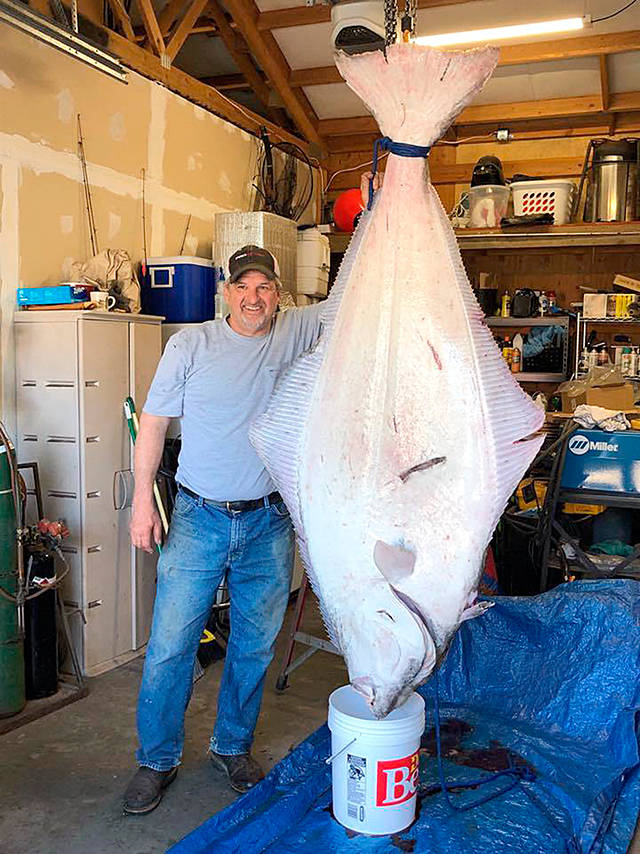SOME GOOD NEWS for halibut anglers, the state Department of Fish and Wildlife added three more days to the recreational flattie fishery in marine areas 3-10, tacking on Saturdays June 16 and 23 and Thursday, June 21.
Last week, Fish and Wildlife added today and Saturday to the halibut schedule after tough fishing conditions left leftover quota poundage remaining.
Saturday’s halibut opening dovetails with the state’s Free Fishing Weekend (Saturday and Sunday).
During those two days, no license will be required to fish or gather shellfish in any waters open to fishing in the state.
But anglers who take the free fishing route will still need a halibut catch record card to mark down any potential catch. Catch record cards are available free at hundreds of sporting goods stores and other license dealers throughout the state.
No vehicle access pass or Discover Pass will be required during Free Fishing Weekend to park at any of the nearly 700 water-access sites maintained by Fish and Wildlife.
A Discover Pass also will not be required on Washington State Parks lands throughout the weekend in celebration of National Get Outdoors Day and the Free Fishing Weekend, but will be required on Department of Natural Resource lands both days.
Mammoth flattie
Whidbey Island angler Tom Hellinger brought aboard a massive 79-inch halibut (pictured above) somewhere in Marina Area 6 (he isn’t telling) in the Strait of Juan de Fuca over Memorial Day weekend.
Hellinger told KCPQ-13 FOX the enormous flattie “came up like the mother-ship.” “Bigger than a folding table.”
It took more than an hour to get into the 24-foot boat, Hellinger said. Fish and Wildlife staff helped measure the fish once he got it to shore. But they couldn’t find a scale to get an official weight.
Hellinger didn’t want to waste the meat waiting for department staff to return from the long weekend, so he had the fish processed, coming away with 140 pounds of filets and tossing the guts and excess.
Most size comparison books put a 79-inch Pacific Halibut at about 270 pounds, he said, just short of the 288-pound state record set in 1988.
Food for thought
Last month a reader named Mike Barton passed along an article from Science magazine that discussed the role of “superspawners” in fisheries management.
Superspawners are fish that produce a disproportionate amount of offspring.
Barton was responding to a comment I made in a May column on the perceived importance large female halibut play in a healthy halibut fishery.
Erik Stokstad, author of the piece in Science, delved into some recent studies that argue for and against that importance.
“It’s been known for decades that fish fertility generally increases with size,” Stokstad wrote. “A cod that is 70 centimeters long, for example, can produce eight times as many eggs as a younger fish half its size can. But it’s been hotly debated whether larger females are especially important for keeping fish stocks healthy. Most of the models used to manage fisheries assume, because of a lack of comprehensive evidence to the contrary, that the most important factor in sustaining a healthy stock is the total amount of spawning fish, regardless of whether it’s a lot of small fish or the same tonnage of big ones.”
Exceptions to this include the Pacific rockfish, in which research shows big females produce even more eggs than predicted by their size. And some of those eggs are extra nutrious, putting offspring at a more advantageous chance at surviving.
For rockfish, which take decades to reach reproductive age, these matriarchs are especially prized because of how long and how many fish it would take to replace their reproduction.
Stokstad points out that climate change also is a concern, as fish tend to be smaller when water temperature rises, making bigger females more valuable.
A study out of Australia and Panama City, Panama looked at how common these disproportionately fertile fish were among species. They looked at 342 species and combined egg size, number, and calories to reveal the total amount of energy each species put into reproducing.
“They found that, in 95 percent of the species, big old females were superspawners,” Stokstad wrote.
The authors of the study believe this data should influence fisheries management, with fishing restricted for many stocks in order to allow more young females to become prolific spawners and over time yield more productive fisheries.
They say the finding also reinforces the argument that marine protected areas, where fishing is often banned and fish are allowed to grow old, can help boost populations.
Stokstad quoted Ray Hilborn, a fisheries biologist at the University of Washington who disagrees.
Hillborn argues that because superspawners are relatively rare, even in unfished populations, their overall contribution to the population is not particularly great. Accounting for superspawners would make “little difference to how you manage a fishery,” he said.
Definitely something to ponder in regard to halibut like the massive fish landed late last month in Marine Area 6.
But something tells me that falliable instinct to “bring it to the boat” kicks in whenever an angler begins to reel in a potentially massive halibut — and research studies go by the wayside.

